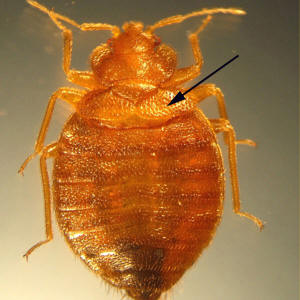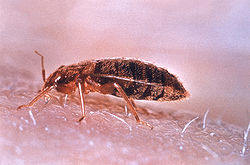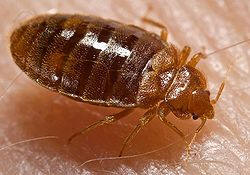 If
you stay in hotels, motels, rental houses and bed-and-breakfasts then you
should read this page that tells you how to check whether the place you are
staying has bed bugs, and what to do to prevent taking bed bugs home with you
from your trip. Studies claim that bedbugs are more prevalent in cheap
(less than $50 per night) hotels and motels) a fact that may make
even Clark Howard consider upgrading to better hotels. According to
ABC news, University of Arizona microbiologist Charles Gerba, PhD,
aka
"Dr. Germ," says
"I did a study about seven years that found if you paid more than $50 a
night, there was a much greater chance that the room was regularly
disinfected. Rooms under $50 weren't."
If
you stay in hotels, motels, rental houses and bed-and-breakfasts then you
should read this page that tells you how to check whether the place you are
staying has bed bugs, and what to do to prevent taking bed bugs home with you
from your trip. Studies claim that bedbugs are more prevalent in cheap
(less than $50 per night) hotels and motels) a fact that may make
even Clark Howard consider upgrading to better hotels. According to
ABC news, University of Arizona microbiologist Charles Gerba, PhD,
aka
"Dr. Germ," says
"I did a study about seven years that found if you paid more than $50 a
night, there was a much greater chance that the room was regularly
disinfected. Rooms under $50 weren't."
Bed bugs are found worldwide. Infestations are growing more common in the developing world, especially in unsanitary living conditions and severe crowding, but in the few years starting in 2001, even in "nice" hotels and airlines. In North America and Western Europe, strong pesticides, like DDT (now banned) made bed bug infestations rare during the second half of the 20th century. The National Pest Management Association reports a 71% increase in calls for bed bug infestations since 2001.
Although bed bugs could theoretically act as a disease carriers (as is actually the case with body lice and fleas) which transmit trench fever commonly among homeless persons ), bed bugs have never been shown to transmit disease. Hepatitis B viral DNA can be detected in bed bugs up to 6 weeks after they feed on infected blood, but no transmission of hepatitis B has been found. There is currently no scientific evidence that these blood-sucking insects spread diseases such as human immunodeficiency virus (HIV). This means, that while the bugs are disgusting, and may produce allergic reactions in some people, they are no considered to be threatening from a medical perspective.

Bedbugs are disgusting bugs that scurry out of a mattress or cracks in the wall to suck human blood in the early morning. As mentioned at the outset, the common bedbug is a small (about the size of an apple seed), reddish-brown, flattened bug that looks a bit like a beetle that exclusively feeds on blood of warm-blooded animals, particularly humans, chickens and bats. They are found in all parts of the world. Bed bugs hide in cracks and crevices in beds, inside mattresses and box springs, wooden furniture, floors, cracks between floorboards, in walls, even behind wall outlets during the daytime. They emerge at night to feed on their preferred host, you and your family! According to Sanitarian Chuck Fisher in this TV interview, "The bed bugs have a tendency to climb the walls, move across the ceilings and drop on you!".

Bedbugs are generally most active just before dawn. Their peak feeding period is about an hour before sunrise. They do feed at other times, too.
If all of this isn't enough to give you insomnia, consider this: they often climb the walls up to the ceiling and then jump down on their human victims, when they feel the warmth of your body and the presence of carbon dioxide rising up.
The bedbug pierces the skin of its host (you) with two hollow tubes.
With one tube it injects its saliva, which contains anticoagulants
and anesthetics, while with the other it withdraws the blood of its
host. After feeding for about five minutes, the bug crawls back to
its hiding place. Normally, the victim won't feel the bites until
minutes or hours later, as the skin reacts to the injected agents.
The first sign of a bite usually comes from the desire to scratch the
bite site.
Although bedbugs can live for a year or as much as
eighteen months without feeding, they typically seek blood every five
to ten days. Bedbugs that go dormant for lack of food often live
longer than a year, well-fed specimens typically live six to nine
months. Low infestations may be difficult to detect, and it is not
unusual for the victim not to even realize they have bedbugs

Since bedbugs inject an anesthetic so you won't feel them bite, you generally will only notice their bites after they have gone back into hiding. The bedbug bites usually affect only the surface of your skin, leaving a small itchy red raised mark. Sometimes the bites appear in a line or cluster, when the bedbug feeds repeatedly.
You might find the lesions in a linear or clustered fashion, indicative of repeated feedings by a single bedbug. Patterns of bites in a row or a cluster are typical as they may be disturbed while feeding. Bites may be found in a variety of places on the body.
It can be difficult to distinguish bedbug bites from other insect bites. Bed bug bites usually:
Some people have no reaction at all to bedbug bites. People who are allergic to the bites may see a reaction in their skin, like larger, itchy bite marks (as big as 6 to 8 inches across - 20 cm), blisters, sometimes filled with pus and other marks of an allergic reaction, like hives. See this page on the Mayo Clinic website for photos of actual bites .
Bed bugs infest only a small proportion of hotels and motels, but they are spreading. Bedbugs hitchhikers in luggage and clothing, frequently on tourists from other nations, military personnel returning from the Middle East, and business travelers traveling less developed nations. It is important to check your hotel room for the signs of a bed bug infestation as soon as you enter the room. Bed bugs hide for all but a couple of hours per day. They prefer places where they won't be disturbed, like cracks in the floor and wall. and the mattress, box spring, and bed frame.
You can also look under wallpaper, behind picture frames, and inside cracks and crevices near beds. Carefully inspect the bed frame, undersides of windows, door casings, and loose moldings. Folds and creases in the bed linens, and seams and tufts of mattresses and box springs, in particular, may harbor bed bugs or their eggs. They may also be found within pleats of curtains, beneath loose areas of wallpaper near the bed, in corners of desks and dressers, within spaces of wicker furniture, behind cove molding, and in laundry or other items on the floor or around the room. Sometimes, characteristic dark brown or reddish fecal spots of bed bugs are apparent on the bed linens, mattress or walls near the bed.
Ways to save money AND help the environment:
Eat healthier AND save money: Instant Pot Duo Crisp 11-in-1 Air Fryer and Electric Pressure Cooker Combo with Multicooker Lids that Fries, Steams, Slow Cooks, Sautés, Dehydrates
Save water AND money with this showerhead adapter, it lets the water flow until the water is hot, then shuts off water flow until you restart it, ShowerStart TSV Hot Water Standby Adapter
Protect your health with these:
Mattress Dust mite-Bedbug protector, 100% Waterproof, Hypoallergenic, Zippered
Handheld Allergen Vacuum Cleaner with UV Sanitizing and Heating for Allergies and Pet, Kills Mite, Virus, Molds, True HEPA with Powerful Suction removes Hair, Dander, Pollen, Dust,
Immune Support Supplement with Quercetin, Vitamin C, Zinc, Vitamin D3
GermGuardian Air Purifier with UV-C Light and HEPA 13 Filter, Removes 99.97% of Pollutants
5 Stage Air Purifier, Features Ultraviolet Light (UVC), H13 True Hepa, Carbon, PCO, Smart Wifi, Auto Mode, Quiet, Removes 99.97% of Particles, Smoke, Mold, Pet Dander, Dust, Odors
Interesting Reads:
THE PREPPER'S CANNING & PRESERVING BIBLE: [13 in 1] Your Path to Food Self-Sufficiency. Canning, Dehydrating, Fermenting, Pickling & More, Plus The Food Preservation Calendar for a Sustainable Pantry
The Backyard Homestead: Produce all the food you need on just a quarter acre! Paperback
The Citizens' Guide to Geologic Hazards: A Guide to Understanding Geologic Hazards Including Asbestos, Radon, Swelling Soils, Earthquakes, Volcanoes
The Uninhabitable Earth: Life After Warming
Book: The Sixth Extinction: An Unnatural History Paperback